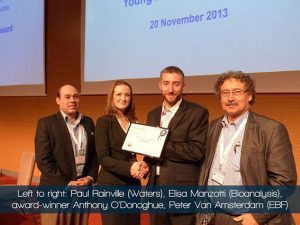NIA Where are they now? Anthony O’Donoghue

Anthony O’Donoghue, Assistant Professor at University of California, San Diego (CA, USA)
Winner of the YIA 2013
What are you current working on and what are your career highlights since winning the NIA?
My current research is focused on detection and characterization of dysregulated protease activity in complex biological samples such a gastric juice, neutrophil extracts and secretions from cancer cells and infectious organisms. The knowledge generated from this research will be used to identify novel proteases as drug targets or for development of diagnostics.
The data generated for these research projects has utilised the mass spectrometry based multiplex substrate profiling assay that I developed in 2012 while a post-doctoral researcher at the University of California San Francisco. In 2013, I was nominated for the NIA by my post-doctoral advisor, Charles Craik, because of my contribution to the bioanalysis field in developing this assay. Since winning the NIA, the main highlight of my career has been to obtain a full-time faculty position at the University of California San Diego.
In addition, I have published 8 peer-reviewed research papers since 2013 and two of these papers received notable media attention. In one study, published in PNAS, we identified a secreted protease from the fungi Pseudogymnoascus destructans that can degrade collagen. This fungus is the causative agent of white nose syndrome, a skin disease that has killed up to 8 million hibernating bats in the US since 2006. We hope that our finding will shed some light on the mechanism of how the fungus penetrates the bat tissue.
In another study, we used the multiplex substrate profiling assay to identify differences in substrate preference between the human proteasome and the malarial proteasome. We used these differences to develop a potent irreversible inhibitor of Plasmodium falciparum, the causative agent of malaria. We subsequently determined that this inhibitor prevents growth of the parasite in a mouse model and can kill artemisinin-resistant strains when co-administered with artemisinin.
What did you hope to achieve when you entered for the award?
At the time of the announcement for the 2013 Bioanalysis Young Investigator nominations, I had started to consider pursing an independent research career in academia. A year earlier, I had developed the mass spectrometry based assay to detect and characterise all known families of proteolytic enzymes. We had used this technique to assay proteases in synovial fluid, blood and cancer cell extracts and therefore we were focused on comparing our method to other bioanalytic techniques.
My post-doctoral advisor, Charles Craik, thought it was perfect timing to nominate me for this award because it would serve to promote my research in the bioanalysis field. Up until then my research was focused in the fields of protease biochemistry and enzymology. Therefore, I had hoped that this opportunity would allow me to present myself and my research to a broader audience. I was very happy to be nominated by Charles and delighted to be chosen as one of the five finalists by the editorial board of Bioanalysis.
What was the impact of receiving the NIA?
Winning the NIA has had a tremendously positive impact on my career. Firstly, it gave me the opportunity to travel to Barcelona to give a research presentation at the 2013 European Bioanalysis Forum. While there, I connected with many people in the bioanalysis field and in particular those who develop HPLCs and Mass Spectrometers. Being connected with technical experts has been helpful for me as I continuously develop the protease substrate profiling assay.
In addition to making connections, being a winner of the Bioanalysis NIA has been an important part of my resume. Two months after winning the award I was invited to the University of Utah to present my research as part of the “Rising Stars” Symposium. The chair of the session introduced me to the audience as the winner of the 2013 Bioanalysis New Investigator Award.
A year later, I began to apply for faculty positions at Universities around the U.S. and was asked at every interview about the NIA. I believe that winning the NIA was an essential step in my research career to become recognized as an independent investigator. I have subsequently joined the faculty of the Skaggs School of Pharmacy and Pharmaceutical Sciences at the University of California San Diego and I proudly have the award certificate hanging in my office.
What are your longer term plans?
I have been an Assistant Professor at the Skaggs School of Pharmacy and Pharmaceutical Sciences at the UC San Diego since July 2015. I am building a research group that will focus on developing blood based enzyme assays for detection of fungal diseases such as candidemia. In addition, we are developing inhibitors against a variety of protease targets in cancer and in infectious disease.
I plan to move into two new areas of research this year. One of these projects will look at the dysregulated protease activity that occurs in our brains following traumatic brain injury. In an unrelated research project, my group will also study the proteases in the gut of individuals with inflammatory bowel disease and how the gut microbiome controls these enzymes. To pursue this research, I have teamed up with several researchers who are experts in brain injury and in gut inflammation. Currently, I have two graduate students, four undergraduates and two senior research technicians in my lab but I hope to double the number of personnel over the next 5 years. In addition to research, I will be teaching an enzymology course to undergraduate students and a mass spectrometry course to Ph.D students. My long term goal is to make the transition from Assistant Professor to full Professor over the next 10 years.
What advice would you offer to other scientists new to bioanalysis?
My advice to other scientists that are new to bioanalysis would be to keep up with the latest technology developments because this area moves quickly and there new technologies being continuously developed. Attending workshops and symposiums will allow you to meet the experts in the field. In addition, journals such as Bioanalysis and updated news forums and webinars, such as those available at Bioanalysis Zone, are key to keeping up to date.
Would you recommend entering the NIA?
At the time of entering the NIA I was quite new to bioanalysis research. My Ph.D research was focused in the field of fungal biology, a research area quite different from bioanalysis. However, after a few years of postdoctoral research, I felt that I had developed an assay that could potentially be used in the bioanalytical field.
Connecting with people in this field was very important for the continued development of my research. However, at the University of California San Francisco where much of the research is focused on biology and drug development, I had difficulties finding the right people to discuss the application of the assay. After entering the NIA and having my profile was published in the July 2013 edition of Bioanalysis, I was now able to send the profile link to potential collaborators in order to aid our discussion.
From one such discussion, I initiated a collaboration with a group of gastroenterology researchers who were looking for ways to distinguish benign pancreatic cysts from malignant pancreatic cysts. We hypothesized that fluid from malignant cysts would contain proteases that were associated with cancer. Using the multiplex substrate profiling assay, we confirmed that this hypothesis was true and we are now developing a quantitative enzyme assay to distinguish malignant from benign pancreatic cysts.
I would advise new investigators to enter the NIA so that you and your research get excellent exposure to people in the bioanalysis field.




